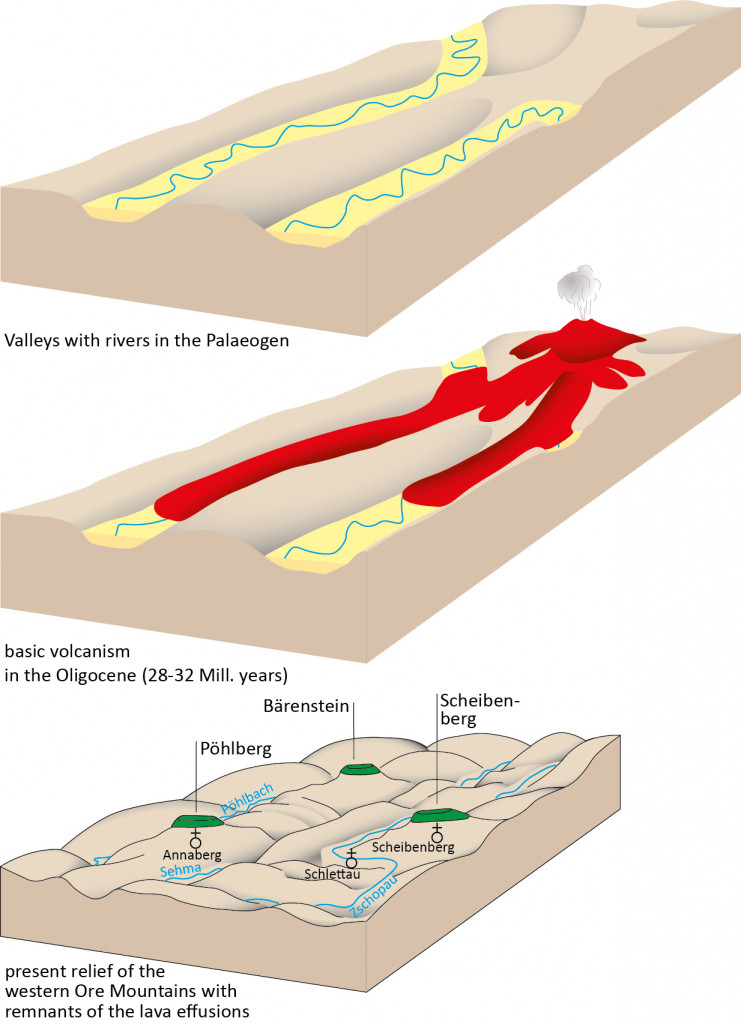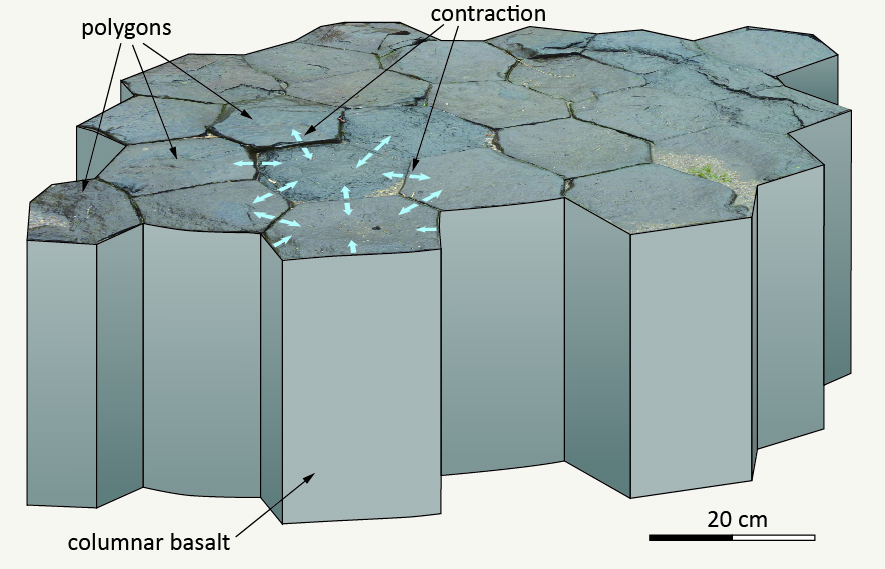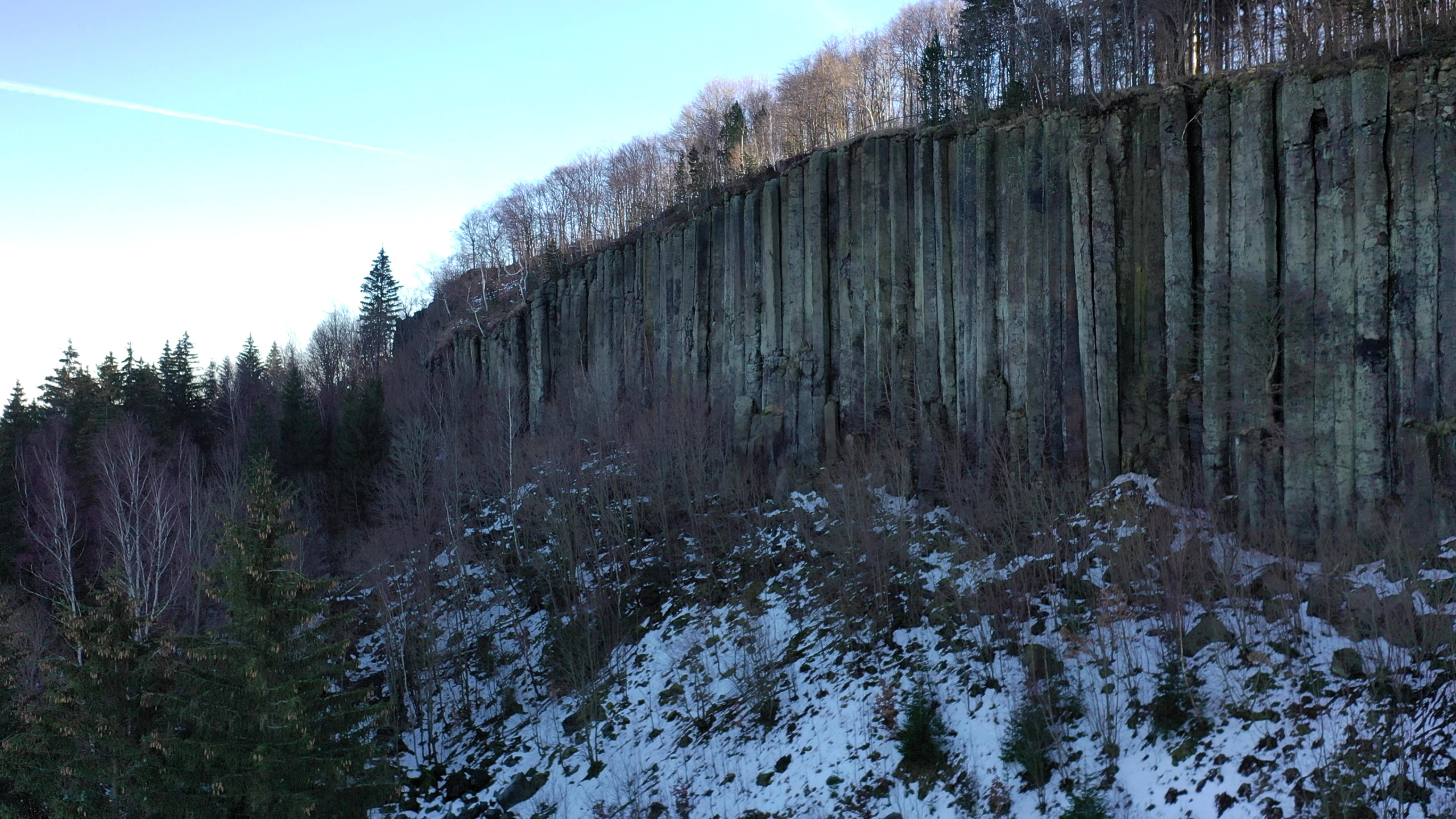Martin Meschede, Universität Greifswald
TL;DR (Too long; did’nt read)
Near the city of Annaberg in the southwestern Ore Mountains in southeastern Germany there is the Scheibenberg with a large outcrop in an abandoned quarry, which cuts in half the summit area of the Scheibenberg and provides an excellent insight into the interior of the mountain. The famous organ pipes of the Scheibenberg are basalt columns of a basalt flow from the Oligocene. Since the 16th century, the hard basalts in the vicinity of the towns of Schlettau and Scheibenberg have been mined for building purposes, worked up as road paving or crushed into gravel. In the 19th century, clays found under the basalts were also mined. Until 1936, basalt columns were broken on the Scheibenberg, before it was put under protection in 1937. The aim was not to further destroy the basalt columns, but rather to preserve them for posterity as an object worthy of special protection. In 2006 the Scheibenberg was raised to the “National Geotope”, an award that was given to a total of 77 geotopes throughout Germany by the Academy of Geosciences in Hannover. In 2019, the geotope was also put under the protection of the UNESCO World Heritage montane region/Krušnohoří.
From a geological point of view, the basalt of the Scheibenberg belongs to the volcanic formations of the Egergraben area (Fig. 1). The Egergraben area has been active as a rift zone since the beginning of the Palaeogene with subsidence zones in the central Egergraben in Bohemia, in the Upper Palatinate and in the Fichtelgebirge. The oldest volcanic rocks found here were formed 65 million years ago in the Czech Osečná complex. The main phase of volcanism was in the Upper Oligocene with volcanic centers in the Czech Doupava Mountains and vent fillings, domes and veins in the Bohemian Uplands. Evidence of volcanism can be observed today, often with impressive columnar basalts, at various locations in the Ore Mountains, as we can observe it at the Scheibenberg.

The age of the Scheibenberg basalt is given as 28-32 million years. The basalt exposed here is a cooled lava flow, which at that time flowed into a valley located there and partially filled it (Fig. 2). The completely vertical basalt columns show that the cooling took place from top to bottom. Morphologically, the Scheibenberg is a classic example of the relief inversion process (Fig. 3). The basalt flow used to flow into a valley, but today it forms a mountain because the surrounding strata, which are made up of sedimentary rocks, are softer and have been eroded away since the Oligocene. The basalt remained as a harding.


As a result of cooling, magmatic melts lose 1–2% of their volume, i.e. they shrink a bit. Similar to what can be observed in clayey layers in drying puddles, in a lava flow that has a little more time to cool down under the isolating solidified surface, a network of shrinkage cracks initially forms at the edge. Continued cooling perpendicular to the cooling surface into the solidifying basaltic lava occurs. This then gives rise to the characteristic basalt columns, which in the past were often regarded as crystal structures, but which represent nothing more than shrinkage cracks in a solidified lava flow (Fig. 4). The column axis is always perpendicular to the cooling front. In lava flows, the columns are therefore vertical, while in chimney fillings they often occur at an angle, lying or curved. Ideally, the columns are hexagonal, as this is the best compromise shape for the smallest surface area with the largest volume. However, they can also have fewer or more corners. The columnar segregation is not limited to basaltic lavas, but also occurs in lavas of other compositions. However, it can be observed particularly frequently in basalts because, due to their lower viscosity, significantly more basaltic than SiO2-rich magmas (e.g. rhyolite) manage to penetrate to the surface and flow out there as lavas.

In the 18th century, a dispute arose between Neptunists and Plutonists, who followed two opposing theories of the formation of the Earth, at the columnar basalt on the Scheibenberg.
The Scheibenberg in the history of science – or: The Neptunist-Plutonist dispute
Basic geoscientific processes were only gradually understood in the 19th century. The question of how rocks were formed had not yet been finally clarified in the 18th century. At that time there were two main camps, the Neptunists and the Plutonists. The disc mountain also played a role in attempts at explanations and was the scene of a historical gathering.
Abraham Gottlob Werner (1749-1817) from Freiberg in Saxony, Germany, was one of the main proponents of the theory of Neptunism, which was also developed very early by Greek philosophers. The theory states that all rocks were deposited as sedimentary rocks from the waters of a hypothetical primordial sea. They could be used to explain fossils, which were of increasing interest to early geoscientists. At that time, Leopold von Buch (1774-1853) was the first to develop the principle of index fossils, which could be used to determine the relative age of rock strata. One of the most famous supporters of the Neptunists was Johann Wolfgang von Goethe (1749-1832) (Fig. 5).

Werner distinguished 4 rock groups, the “primordial mountain type“, to which he counted granite, gneiss, mica slate, argillaceous slate, porphyry, quartzite, serpentinite and basalt; the “seam mountain type” with sandstone, greywacke, chalk, rock salt and gypsum, the “volcanic mountain type” with pumice, tuff, volcanic ash and lava, and the “floated mountain type” with placers and bog ironstone. He initially considered volcanism to be insignificant and believed it to be caused by coal and seam fires. From 1788 he counted the basalt to the floated mountain type. Werner explained granites as the first deposits that arose as chemical precipitation from the primeval ocean. With the explanation that all rocks were formed in water, Werner ties in with the biblical doctrine of creation, which is why this theory was also accepted by the church. The catastrophe theories discussed at the time were also included in his considerations.
Plutonism was opposed to Neptunism. This theory states that all rocks were originally formed by volcanic forces from the earth’s interior. The concept of plutonism still exists today: magma penetrates the earth’s crust and solidifies into plutons. The English naturalist and geologist James Hutton (1726-1797), who is also considered the founder of modern geology, was the main developer of the theory of plutonism. He assumed that the creative forces emanate from the “central fire” in the interior of the earth. Rocks, mountains, continents and volcanism could be explained with it. This theory, which can be classified as far from the Bible, was initially rejected.
With the question “How did the basalt form?” a bitter argument ensued between the Plutonists and Neptunists. A high point of this debate was in 1787/1788, when representatives of both hypotheses met on the Scheibenberg in the southwestern Ore Mountains to discuss the various theories. However, they did not agree because both sides put forward arguments that could not be refuted by the other side.
Werner saw washed-in sand in the rocks of the Scheibenberg, which was later covered by clay, which then gradually formed into basalt, so to speak “crystallized“. Johann Carl Wilhelm Voigt (1752-1821), a former student of Werner (!), spoke for the plutonists. He recognized that basalt is of volcanic origin and assumed this also for the Scheibenberg. In 1823 Goethe wrote the essay on this dispute: “Comparative proposals to unite the Vulcans and Neptunians about the formation of basalt“. Even in his Faust II he has the Greek natural philosophers Thales of Miletus and Anaxagoras discuss the cool tranquility of the water-born forces of nature and the violence of the fire-born forces.
Alexander von Humboldt (1769-1859), who was also a student of Werner and initially belonged to the group of Neptunists, wrote about volcanoes in various “earth zones“. He has traveled to many parts of the world and seen numerous volcanic phenomena. Eventually he changed his mind about the formation of the rocks and sided with the plutonists. And he unsettled Goethe, who later also joined the Plutonists after the convincing reports of Humboldt. Goethe wrote the following poem about Humboldt’s investigations:

America, thou hast it better
Than our ancient hemisphere;
Thou hast no falling castles,
Nor basalt, as here.
Thy children, they know not,
Their youthful prime to mar,
Vain retrospection,
Nor ineffective war.
Fortune wait on thy glorious spring!
And, when in time thy poets sing,
May some good genius guard them all
From Baron, Robber, Knight, and Ghost traditional.
In conclusion, one can say that the Plutonist-Neptunist dispute fueled modern geology after a very arduous path and finally led to the theory of plate tectonics about 150 years later (cf. Hess, 1962). Actually, both theories are somewhat correct, the Plutonists perhaps a little more than the Neptunists, but both theories are included in today’s Earth formation theories.
3D model
References
Hess, H.H. (1962) History of Ocean Basins. In: Engel, A.E.J., James, H.L. and Leonard, B.F., Eds., Petrologic Studies: A Volume to Honor A. F. Buddington, Geological Society of America, Boulder, 599-620.
Meschede, M. (2018): Geologie Deutschlands – ein prozessorientierter Ansatz. – 196 S., 6. Auflage (1. Auflage 2005), Wiss. Buchges., wbg Academic, Darmstadt.
Meschede, M., Warr, L. (2019): The Geology of Germany – a process-oriented approach. – 303 S., Springer Nature Switzerland.
Nickschick, T., Kämpf, H., Jahr, T. (2014): The “Triasscholle” near Greiz, Germany – a volcanic origin? – Bull. Volcanol., 76: 806-826.
Pfeiffer, L., Suhr, P. (2008): Tertiärer Vulkanismus. – In: Pälchen, W., Walter, H. (Hrsg.),
Geologie von Sachsen, S. 486–494; Schweizerbart’sche Verlagsbuchhandlung, Stuttgart.
Sebastian, U. (2013): Die Geologie des Erzgebirges. – 270 S. Springer-Verlag, Berlin Heidelberg.
Wagenbreth, O., Steiner, W. (2001): Geologische Streifzüge: Landschaft und Erdgeschichte zwischen Kap Arkona und Fichtelberg. – 204 S., 4. Auflage (1. Auflage 1990), Springer Spektrum, Berlin-Heidelberg.


